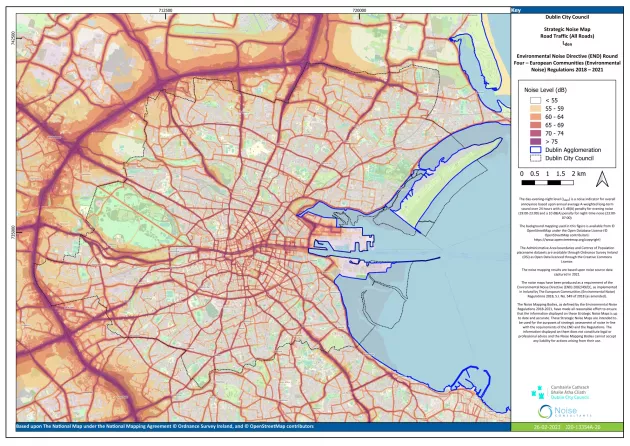Dublin City and Dublin Agglomeration Strategic Noise Maps

The Environmental Noise Directive (END) and the European Communities (Environmental Noise) Regulations 2018 to 2021 (The Regulations) requires Strategic Noise Maps to be prepared for the agglomeration of Dublin for each of the following noise sources;
- Road Traffic (All Roads and Major Roads)
- Railway Traffic (All Rail and Major Rail)
- Aircraft (Major airports)
- Industry including ports.
Strategic Noise Maps for road, rail and industry are included here for Dublin City Council’s administrative area only and also the full agglomeration of Dublin.
The Strategic Noise Maps present noise contours for the following two noise indicators in line with the requirements of The Regulations;
- Lden - The day - evening - night level is a noise indicator for overall annoyance based upon annual average A-weighted long-term sound over 24 hours with a 5dB(A) penalty for evening noise (19:00 – 23:00) and a 10 dB(A) penalty for night time noise (23:00 – 07:00). Lden noise levels above the threshold of 55dB are required to be reported to the European Commission.
- Lnight – The night level is a noise indicator for sleep disturbance based upon annual average A-weighted long-term sound over the night period (23:00 – 07:00). Lnight noise levels above the threshold of 50dB are required to be reported to the European Commission.
Noise levels that are at or above the noise indicator thresholds set out above are presented at 5 dB contours, i.e. there are no contours representing values below the required reporting thresholds included on the maps.
The noise contours are not based on measurements but have been prepared using computer modelling in-line with a common noise assessment methodology adopted by the European Commission in line with Article 6.2 of the EC Directive 2002/49/EC and brought into effect through Commission Directive (EU) 2015/996. The new common methodology is called CNOSSOS – EU and further details can be found at this link [https://publications.jrc.ec.europa.eu/repository/handle/JRC72550]. This new common assessment methodology has been used for the first time in Round 4. Strategic noise maps for Dublin for Round’s 1 to 3 were produced using a different recognised methodology available at that time. This change should be considered when making any direct comparisons between the Round 4 maps and maps for previous Rounds as the modelling methodologies as well as input data sets will have changed.
The purpose of the Strategic Noise Maps are to;
- Provide relevant data to the European Commission in accordance with the requirements of the Environmental Noise Directive,
- Provide a source of information for the general public on environmental noise and its effects,
- Provide the basis for developing Noise Action Plans to identify noise priority areas and quiet areas and propose relevant mitigation measures to help mitigate the harmful effects of these noise sources.
The Strategic Noise Maps and associated results are a representation of the predicted situation with regards to noise in a particular area for each of the noise sources set out above.
The results should not be used to determine ambient noise levels at specific locations for the purposes of submitting information for planning applications, the enforcement of noise specific planning conditions or writing Environmental Impact Assessments. A more detailed examination of noise issues will be required for these purposes and should involve monitoring to determine ambient noise levels at relevant locations.
The Strategic Noise Maps for Dublin City and the agglomeration of Dublin can be downloaded using the links below.
In addition the Strategic Noise Maps can be viewed on the EPA Map site https://gis.epa.ie/EPAMaps/ and a guide to viewing them can be downloaded below.
Dublin City Council Strategic Noise Maps
Dublin Agglomeration Strategic Noise Maps